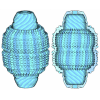+ Open data
Open data
- Basic information
Basic information
| Entry | Database: PDB / ID: 4erk | ||||||
|---|---|---|---|---|---|---|---|
| Title | THE COMPLEX STRUCTURE OF THE MAP KINASE ERK2/OLOMOUCINE | ||||||
 Components Components | EXTRACELLULAR REGULATED KINASE 2 | ||||||
 Keywords Keywords | TRANSFERASE / SERINE/THREONINE-PROTEIN KINASE / MAP KINASE / ERK2 | ||||||
| Function / homology |  Function and homology information Function and homology informationphospho-PLA2 pathway / RAF-independent MAPK1/3 activation / MAPK1 (ERK2) activation / Signaling by NODAL / Frs2-mediated activation / ERK/MAPK targets / ERKs are inactivated / Activation of the AP-1 family of transcription factors / Transcriptional and post-translational regulation of MITF-M expression and activity / Negative feedback regulation of MAPK pathway ...phospho-PLA2 pathway / RAF-independent MAPK1/3 activation / MAPK1 (ERK2) activation / Signaling by NODAL / Frs2-mediated activation / ERK/MAPK targets / ERKs are inactivated / Activation of the AP-1 family of transcription factors / Transcriptional and post-translational regulation of MITF-M expression and activity / Negative feedback regulation of MAPK pathway / Gastrin-CREB signalling pathway via PKC and MAPK / Estrogen-dependent nuclear events downstream of ESR-membrane signaling / IFNG signaling activates MAPKs / Golgi Cisternae Pericentriolar Stack Reorganization / RHO GTPases Activate WASPs and WAVEs / Estrogen-stimulated signaling through PRKCZ / Growth hormone receptor signaling / Spry regulation of FGF signaling / SMAD2/SMAD3:SMAD4 heterotrimer regulates transcription / Senescence-Associated Secretory Phenotype (SASP) / Oncogene Induced Senescence / Regulation of actin dynamics for phagocytic cup formation / Downregulation of SMAD2/3:SMAD4 transcriptional activity / Signal attenuation / Oxidative Stress Induced Senescence / NCAM signaling for neurite out-growth / Negative regulation of FGFR1 signaling / Negative regulation of FGFR3 signaling / Negative regulation of FGFR4 signaling / Regulation of the apoptosome activity / Signaling by Activin / Negative regulation of FGFR2 signaling / Signal transduction by L1 / RHO GTPases Activate NADPH Oxidases / Negative regulation of MAPK pathway / PI5P, PP2A and IER3 Regulate PI3K/AKT Signaling / Interferon gamma signaling / FCERI mediated MAPK activation / Regulation of HSF1-mediated heat shock response / diadenosine tetraphosphate biosynthetic process / MAP2K and MAPK activation / neural crest cell development / Recycling pathway of L1 / cardiac neural crest cell development involved in heart development / caveolin-mediated endocytosis / cytosine metabolic process / response to epidermal growth factor / cellular response to methionine / cellular response to toxic substance / positive regulation of macrophage proliferation / regulation of cellular pH / outer ear morphogenesis / regulation of Golgi inheritance / RAF/MAP kinase cascade / mitogen-activated protein kinase kinase kinase binding / response to alcohol / ERBB signaling pathway / Thrombin signalling through proteinase activated receptors (PARs) / labyrinthine layer blood vessel development / mammary gland epithelial cell proliferation / trachea formation / Neutrophil degranulation / regulation of early endosome to late endosome transport / regulation of stress-activated MAPK cascade / steroid hormone receptor signaling pathway / cellular response to insulin-like growth factor stimulus / androgen receptor signaling pathway / positive regulation of macrophage chemotaxis / ERBB2-ERBB3 signaling pathway / response to testosterone / regulation of cytoskeleton organization / response to exogenous dsRNA / pseudopodium / lung morphogenesis / face development / positive regulation of telomere maintenance / Bergmann glial cell differentiation / decidualization / thyroid gland development / peptidyl-threonine phosphorylation / progesterone receptor signaling pathway / MAP kinase activity / regulation of ossification / negative regulation of cell differentiation / mitogen-activated protein kinase / phosphatase binding / Schwann cell development / estrous cycle / stress-activated MAPK cascade / positive regulation of cardiac muscle cell proliferation / cellular response to platelet-derived growth factor stimulus / ERK1 and ERK2 cascade / phosphotyrosine residue binding / myelination / sensory perception of pain / RNA polymerase II CTD heptapeptide repeat kinase activity / dendrite cytoplasm / insulin-like growth factor receptor signaling pathway / lipopolysaccharide-mediated signaling pathway / cellular response to epidermal growth factor stimulus Similarity search - Function | ||||||
| Biological species |  | ||||||
| Method |  X-RAY DIFFRACTION / X-RAY DIFFRACTION /  MOLECULAR REPLACEMENT / Resolution: 2.2 Å MOLECULAR REPLACEMENT / Resolution: 2.2 Å | ||||||
 Authors Authors | Wang, Z. / Canagarajah, B. / Boehm, J.C. / Cobb, M.H. / Young, P.R. / Abdel-Meguid, S. / Adams, J.L. / Goldsmith, E.J. | ||||||
 Citation Citation |  Journal: Structure / Year: 1998 Journal: Structure / Year: 1998Title: Structural basis of inhibitor selectivity in MAP kinases. Authors: Wang, Z. / Canagarajah, B.J. / Boehm, J.C. / Kassisa, S. / Cobb, M.H. / Young, P.R. / Abdel-Meguid, S. / Adams, J.L. / Goldsmith, E.J. | ||||||
| History |
|
- Structure visualization
Structure visualization
| Structure viewer | Molecule:  Molmil Molmil Jmol/JSmol Jmol/JSmol |
|---|
- Downloads & links
Downloads & links
- Download
Download
| PDBx/mmCIF format |  4erk.cif.gz 4erk.cif.gz | 86.8 KB | Display |  PDBx/mmCIF format PDBx/mmCIF format |
|---|---|---|---|---|
| PDB format |  pdb4erk.ent.gz pdb4erk.ent.gz | 65.3 KB | Display |  PDB format PDB format |
| PDBx/mmJSON format |  4erk.json.gz 4erk.json.gz | Tree view |  PDBx/mmJSON format PDBx/mmJSON format | |
| Others |  Other downloads Other downloads |
-Validation report
| Summary document |  4erk_validation.pdf.gz 4erk_validation.pdf.gz | 448.6 KB | Display |  wwPDB validaton report wwPDB validaton report |
|---|---|---|---|---|
| Full document |  4erk_full_validation.pdf.gz 4erk_full_validation.pdf.gz | 465.5 KB | Display | |
| Data in XML |  4erk_validation.xml.gz 4erk_validation.xml.gz | 10.9 KB | Display | |
| Data in CIF |  4erk_validation.cif.gz 4erk_validation.cif.gz | 16.1 KB | Display | |
| Arichive directory |  https://data.pdbj.org/pub/pdb/validation_reports/er/4erk https://data.pdbj.org/pub/pdb/validation_reports/er/4erk ftp://data.pdbj.org/pub/pdb/validation_reports/er/4erk ftp://data.pdbj.org/pub/pdb/validation_reports/er/4erk | HTTPS FTP |
-Related structure data
| Related structure data |  1a9uC 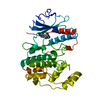 1bl6C  1bl7C 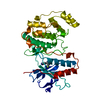 1bmkC  3erkC  1erk S: Starting model for refinement C: citing same article ( |
|---|---|
| Similar structure data |
- Links
Links
- Assembly
Assembly
| Deposited unit | 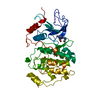
| ||||||||
|---|---|---|---|---|---|---|---|---|---|
| 1 |
| ||||||||
| Unit cell |
|
- Components
Components
| #1: Protein | Mass: 42159.434 Da / Num. of mol.: 1 Source method: isolated from a genetically manipulated source Source: (gene. exp.)   References: UniProt: P63086, Transferases; Transferring phosphorus-containing groups; Phosphotransferases with an alcohol group as acceptor |
|---|---|
| #2: Chemical | ChemComp-SO4 / |
| #3: Chemical | ChemComp-OLO / |
| #4: Water | ChemComp-HOH / |
-Experimental details
-Experiment
| Experiment | Method:  X-RAY DIFFRACTION / Number of used crystals: 1 X-RAY DIFFRACTION / Number of used crystals: 1 |
|---|
- Sample preparation
Sample preparation
| Crystal | Density Matthews: 2.6 Å3/Da / Density % sol: 53 % | ||||||||||||||||||||||||||||||||||||||||||||||||||||||||||||||||||||||||
|---|---|---|---|---|---|---|---|---|---|---|---|---|---|---|---|---|---|---|---|---|---|---|---|---|---|---|---|---|---|---|---|---|---|---|---|---|---|---|---|---|---|---|---|---|---|---|---|---|---|---|---|---|---|---|---|---|---|---|---|---|---|---|---|---|---|---|---|---|---|---|---|---|---|
| Crystal grow | pH: 6.1 / Details: pH 6.1 | ||||||||||||||||||||||||||||||||||||||||||||||||||||||||||||||||||||||||
| Crystal | *PLUS | ||||||||||||||||||||||||||||||||||||||||||||||||||||||||||||||||||||||||
| Crystal grow | *PLUS pH: 7.4 / Method: vapor diffusionDetails: Wang, Z., (1997) Proc. Natl. Acad. Sci. USA, 94, 2327. | ||||||||||||||||||||||||||||||||||||||||||||||||||||||||||||||||||||||||
| Components of the solutions | *PLUS
|
-Data collection
| Diffraction | Mean temperature: 100 K |
|---|---|
| Diffraction source | Source:  ROTATING ANODE / Type: RIGAKU RUH3R / Wavelength: 1.5418 ROTATING ANODE / Type: RIGAKU RUH3R / Wavelength: 1.5418 |
| Detector | Type: RIGAKU RAXIS IIC / Detector: IMAGE PLATE / Date: Jan 1, 1997 / Details: MIRRORS |
| Radiation | Monochromatic (M) / Laue (L): M / Scattering type: x-ray |
| Radiation wavelength | Wavelength: 1.5418 Å / Relative weight: 1 |
| Reflection | Resolution: 2→40 Å / Num. obs: 21746 / % possible obs: 83.5 % / Observed criterion σ(I): 2 / Redundancy: 2 % / Rsym value: 0.034 / Net I/σ(I): 20 |
| Reflection shell | Resolution: 2→2.07 Å / Redundancy: 2 % / Mean I/σ(I) obs: 2 / Rsym value: 0.371 / % possible all: 77 |
| Reflection | *PLUS Num. obs: 26042 / Num. measured all: 99305 / Rmerge(I) obs: 0.042 |
- Processing
Processing
| Software |
| ||||||||||||||||||||
|---|---|---|---|---|---|---|---|---|---|---|---|---|---|---|---|---|---|---|---|---|---|
| Refinement | Method to determine structure:  MOLECULAR REPLACEMENT MOLECULAR REPLACEMENTStarting model: PDB ENTRY 1ERK  1erk Resolution: 2.2→20 Å / Data cutoff high absF: 10000000 / Data cutoff low absF: 0.001 / σ(F): 2
| ||||||||||||||||||||
| Refinement step | Cycle: LAST / Resolution: 2.2→20 Å
|
 Movie
Movie Controller
Controller



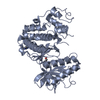
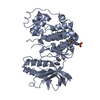
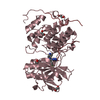


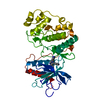
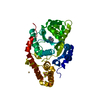


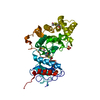
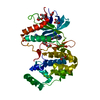

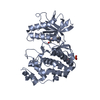

 PDBj
PDBj






